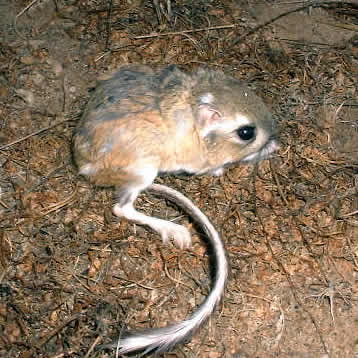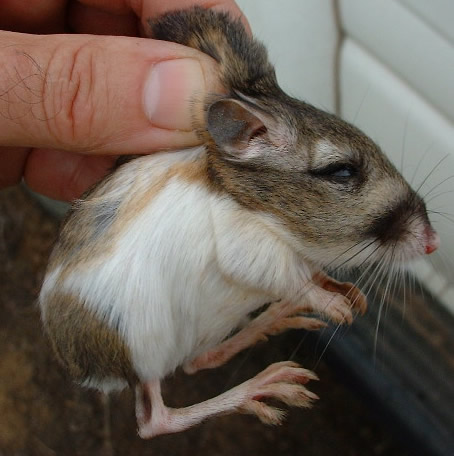Consulting | Bats | Rodents |
||
Aside from collecting rodents as a student assistant in the university museum from 1964-1968, I began serious work with rodents in 1971. My dissertation examined small mammal community structure and habitat partitioning in a sagebrush habitat north of Reno, Nevada. This developed my skills in live trapping as well as establishing the methods for describing movements, behavior, and habitat use both spatially and temporally. After graduation, I spent a year in South Carolina at the Savannah River Plant on a post-doctoral fellowship. My task was continued work on small mammals. Studies ranged from mission-oriented tasks on thermal ecology and elemental cycling to broader topics including the development of a live trapping use of the assessment line method for estimating density small mammals. I returned to southern Nevada to conduct a 2-year contract to collect baseline biological information for a proposed power plant outside Las Vegas, Nevada. This entailed concentrated small mammal trapping, including further development and refinement of the assessment line technique. I was then awarded a 2-year contract with the National Park Service to assess the impact of feral burros on the Lake Mead National Recreation Area. One tool that I used was differentials in rodent density, assuming that increased resource use by burros would lower the carrying capacity for rodents.
This 4-year introduction into contract biology led to my acceptance of a position as senior scientist for WESTEC Services, a San Diego-based consulting firm. I operated a field office for them in Las Vegas. I designed and implemented large-scale biological inventories and necessarily evaluated potential or actual impacts by various activities. In 1983, we obtained a contract to evaluate a potential solar installation in northern San Diego County, California. I discovered the presence of a state-listed threatened species, the Stephens' kangaroo rat. This represented a disjunct distribution and major range extension of a significantly large population. Subsequent contracts to evaluate the distribution and abundance of this new population necessitated development of new methods for implementation of rapid large-scale surveys. I followed up with a quantitative study to evaluate conditions prior to development and then changes in density through construction and into operation of the solar facility. In 1984, I became an independent consultant and started O'Farrell Biological Consulting. Although contract work was varied, additional contracts for Stephens' kangaroo rat were secured over the next few years. During a siting study for placement of power line towers and associated access roads in western Riverside County, California, I discovered a large population of the kangaroo rat within the project alignment. This prompted a detailed study on density and habitat selection. Subsequently, focused surveys for occurrence and detailed mapping of distribution became more common. As mitigation for development of a state fair ground, I performed initial studies to determine effects of various habitat manipulations on densities of resident kangaroo rats. In 1987, I contracted with the California Department of Fish and Game to reexamine historic locations of Stephens' kangaroo rat occupation, delineate current areas of occupation, evaluate threats to existing occupied areas, and where practicable locate new areas of occupation. Among the difficulties associated with this contract were insufficient funding and lack of approval for access to private lands over a substantial area of western Riverside County, extreme southwestern San Bernardino County, and northern San Diego County. The product was far more encompassing than originally planned, including a comprehensive mapping of all populations on USGS 7.5' topographic maps. Fortuitously, the report and maps were in draft form at the time the kangaroo rat became federally listed as endangered. The maps formed the initial baseline for evaluating potential preserve locations. Federal listing of Stephens' kangaroo rat triggered an incredible number of contracts, mainly determining presence/absence and if present, the amount of occupied habitat. Associated with the increased need to evaluate impacts to small projects throughout western Riverside County was the stated need to develop a new water reservoir, initially referred to as the Eastside Reservoir. I performed the evaluation for Stephens' kangaroo rat on all site alternatives, which allowed for replicate sampling of sites across the range of the species in western Riverside County and included the full range of population densities. Incorporated within this sampling was a detailed evaluation of habitats through quantitative plant transects. Thus, I was able to establish a more thorough understanding of habitat relationships and effect of habitat on carrying capacity. Further, continued quantification of active burrow entrances on each trapping plot resulted in development of a predictive model to estimate density based on standardized burrow count transects. This was a critical step in developing a monitoring plan because Stephens' kangaroo rat was notoriously difficult to capture and during the period from onset of the rainy season through complete drying in the summer, the majority of individuals were simply not trappable. Estimating density from burrow counts provided consistent year to year evaluation of population levels regardless of environmental factors that were known to affect trappability.
During this time, we were tasked with trapping and displacing resident kangaroo rats from a fenced working right-of-way for a large water pipeline in front of the dam at Skinner Reservoir east of Temecula. Authorization to proceed with the trap out was delayed until after the rains began. As trapping started, so did germination resulting in rapid growth of grasses and forbs. Some kangaroo rats were captured and moved outside the fence but fresh scat, tracks and digging indicated more individuals were still present. The project was on hold until all animals were moved. We trapped for 8 weeks with no further success. I had a flock of sheep brought in and grazed the area intensively. Opening of the habitat resulted in the capture of a juvenile kangaroo rat. In desperation, I decided to use some mesh traps designed and manufactured for Palmer's chipmunk trapping in the 1980s. These traps were hardware cloth with a stainless steel door and teeter-totter treadle. One was placed next to each Sherman live trap. Within a week the remaining kangaroo rats were captured. I began using the mesh next to Sherman traps in focused salvage trapping efforts. All captures were in mesh traps. It became evident that a rigorous evaluation of mesh traps was necessary. We proceeded to sample as many habitats in California and Nevada as possible and determined that mesh traps provided significantly better results. The burrow count transect density model was adjusted based on mesh trap results. The interim Habitat Conservation Plan for western Riverside County allowed for permitted take of certain occupied lands. I was awarded a contract from the Metropolitan Water District of Southern California to develop a methodology for translocating kangaroo rats from areas permitted for development to prepared areas within designated preserve settings. This necessitated establishment of protocols for habitat rehabilitation and enhancement in order to prepare potentially suitable but unoccupied habitat at Lake Mathews for kangaroo rat introduction. Simultaneously my best friend, Herb Emmerson developed an animal facility to house several hundred salvaged kangaroo rats for over a year. The translocation was a success and formed the basis of future translocation efforts. Simultaneous with the translocation study was an additional contract to develop a monitoring and management plan for the newly formed Shipley/Skinner Preserve. Data from Lake Mathews was also used to develop this plan. After 5 years of study, a formal monitoring and management plan was completed in 1997. Throughout this entire period, other rodent work was conducted. I developed specific methods for surveying the California state-listed threatened Mojave ground squirrel, particularly along linear utility corridors. As part of this effort, my wife Theda designed and manufactured functional shade covers for ground squirrel trapping. We also adapted the general survey methods I developed for Stephens' kangaroo rat to the unique conditions in the Houserock Valley in the Arizona Strip for the endemic subspecies of chisel-toothed kangaroo rat. We conducted the only comprehensive survey for this animal including mapping the entire distribution and the overlying vegetation mosaic. I was also brought onto the Morro Bay kangaroo rat Recovery Team and assisted in updating the Recovery Plan. We also conducted a series of surveys throughout the entire historic range of the species. Unfortunately, the results have indicated the extinction of the Morro Bay kangaroo rat. In the late 1990s, the San Bernardino Merriam's kangaroo rat was federally listed prompting the beginning of a number of surveys. A major effort included mapping the distribution and determination of population levels in early, mid-seral, and mature habitat within the Santa Ana River drainage associated with the construction of the Seven Oaks Dam. The other major locus of distribution of the species within Lytle Creek and Cajon Wash is dominated by sand and gravel mining operations. One of the largest, Vulcan Materials, contracted with me to perform a translocation of animals from a permitted expansion of mining operations to reconstructed and revegetated benches in post-mining areas. The translocation was successful. In 2002, Lytle Development Company contracted with me to develop a mitigation program to allow development of a portion of their property in northern Lytle Creek. Development of this plan resulted in the initiation of a long-term study to rehabilitate and enhance habitat on an island area above the 100 year flood level within the main drainage and part of a designated conservation area. Preliminary results are encouraging. |
||

